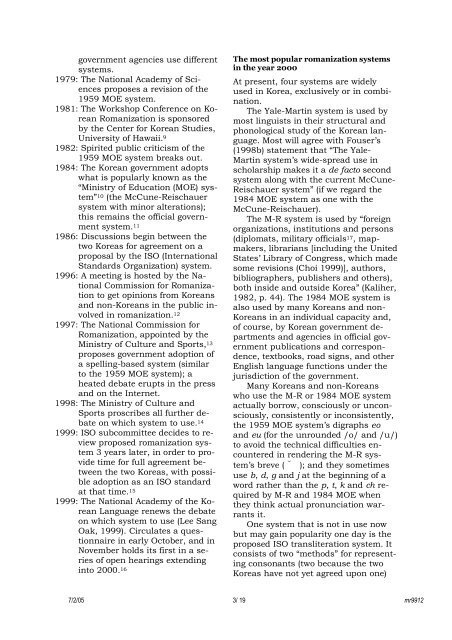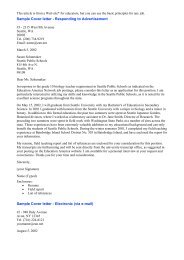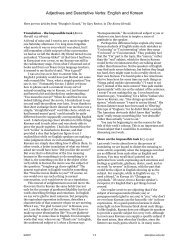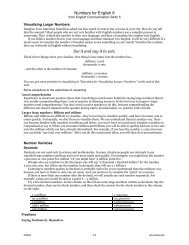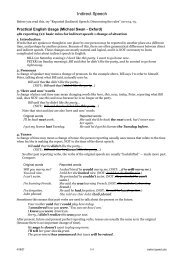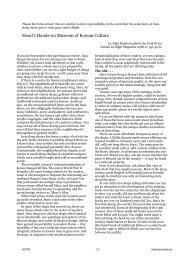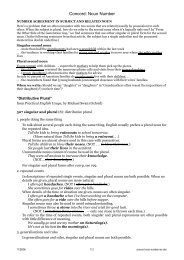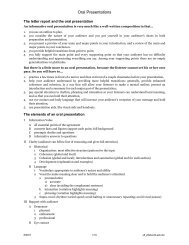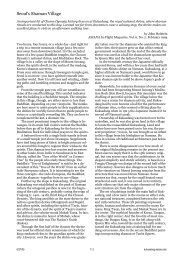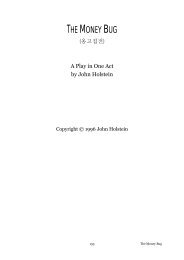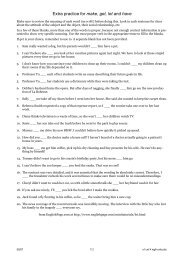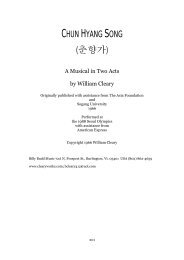The McCune-Reischauer Korean Romanization ... - Korea Mosaic
The McCune-Reischauer Korean Romanization ... - Korea Mosaic
The McCune-Reischauer Korean Romanization ... - Korea Mosaic
Create successful ePaper yourself
Turn your PDF publications into a flip-book with our unique Google optimized e-Paper software.
government agencies use different<br />
systems.<br />
1979: <strong>The</strong> National Academy of Sciences<br />
proposes a revision of the<br />
1959 MOE system.<br />
1981: <strong>The</strong> Workshop Conference on <strong><strong>Korea</strong>n</strong><br />
<strong>Romanization</strong> is sponsored<br />
by the Center for <strong><strong>Korea</strong>n</strong> Studies,<br />
University of Hawaii. 9<br />
1982: Spirited public criticism of the<br />
1959 MOE system breaks out.<br />
1984: <strong>The</strong> <strong><strong>Korea</strong>n</strong> government adopts<br />
what is popularly known as the<br />
“Ministry of Education (MOE) system”<br />
10 (the <strong>McCune</strong>-<strong>Reischauer</strong><br />
system with minor alterations);<br />
this remains the official government<br />
system. 11<br />
1986: Discussions begin between the<br />
two <strong>Korea</strong>s for agreement on a<br />
proposal by the ISO (International<br />
Standards Organization) system.<br />
1996: A meeting is hosted by the National<br />
Commission for <strong>Romanization</strong><br />
to get opinions from <strong><strong>Korea</strong>n</strong>s<br />
and non-<strong><strong>Korea</strong>n</strong>s in the public involved<br />
in romanization. 12<br />
1997: <strong>The</strong> National Commission for<br />
<strong>Romanization</strong>, appointed by the<br />
Ministry of Culture and Sports, 13<br />
proposes government adoption of<br />
a spelling-based system (similar<br />
to the 1959 MOE system); a<br />
heated debate erupts in the press<br />
and on the Internet.<br />
1998: <strong>The</strong> Ministry of Culture and<br />
Sports proscribes all further debate<br />
on which system to use. 14<br />
1999: ISO subcommittee decides to review<br />
proposed romanization system<br />
3 years later, in order to provide<br />
time for full agreement between<br />
the two <strong>Korea</strong>s, with possible<br />
adoption as an ISO standard<br />
at that time. 15<br />
1999: <strong>The</strong> National Academy of the <strong><strong>Korea</strong>n</strong><br />
Language renews the debate<br />
on which system to use (Lee Sang<br />
Oak, 1999). Circulates a questionnaire<br />
in early October, and in<br />
November holds its first in a series<br />
of open hearings extending<br />
into 2000. 16<br />
<strong>The</strong> most popular romanization systems<br />
in the year 2000<br />
At present, four systems are widely<br />
used in <strong>Korea</strong>, exclusively or in combination.<br />
<strong>The</strong> Yale-Martin system is used by<br />
most linguists in their structural and<br />
phonological study of the <strong><strong>Korea</strong>n</strong> language.<br />
Most will agree with Fouser’s<br />
(1998b) statement that “<strong>The</strong> Yale-<br />
Martin system’s wide-spread use in<br />
scholarship makes it a de facto second<br />
system along with the current <strong>McCune</strong>-<br />
<strong>Reischauer</strong> system” (if we regard the<br />
1984 MOE system as one with the<br />
<strong>McCune</strong>-<strong>Reischauer</strong>).<br />
<strong>The</strong> M-R system is used by “foreign<br />
organizations, institutions and persons<br />
(diplomats, military officials 17 , mapmakers,<br />
librarians [including the United<br />
States’ Library of Congress, which made<br />
some revisions (Choi 1999)], authors,<br />
bibliographers, publishers and others),<br />
both inside and outside <strong>Korea</strong>” (Kaliher,<br />
1982, p. 44). <strong>The</strong> 1984 MOE system is<br />
also used by many <strong><strong>Korea</strong>n</strong>s and non-<br />
<strong><strong>Korea</strong>n</strong>s in an individual capacity and,<br />
of course, by <strong><strong>Korea</strong>n</strong> government departments<br />
and agencies in official government<br />
publications and correspondence,<br />
textbooks, road signs, and other<br />
English language functions under the<br />
jurisdiction of the government.<br />
Many <strong><strong>Korea</strong>n</strong>s and non-<strong><strong>Korea</strong>n</strong>s<br />
who use the M-R or 1984 MOE system<br />
actually borrow, consciously or unconsciously,<br />
consistently or inconsistently,<br />
the 1959 MOE system’s digraphs eo<br />
and eu (for the unrounded /o/ and /u/)<br />
to avoid the technical difficulties encountered<br />
in rendering the M-R system’s<br />
breve ( ˘ ); and they sometimes<br />
use b, d, g and j at the beginning of a<br />
word rather than the p, t, k and ch required<br />
by M-R and 1984 MOE when<br />
they think actual pronunciation warrants<br />
it.<br />
One system that is not in use now<br />
but may gain popularity one day is the<br />
proposed ISO transliteration system. It<br />
consists of two “methods” for representing<br />
consonants (two because the two<br />
<strong>Korea</strong>s have not yet agreed upon one)<br />
7/2/05 3/ 19 mr9912


